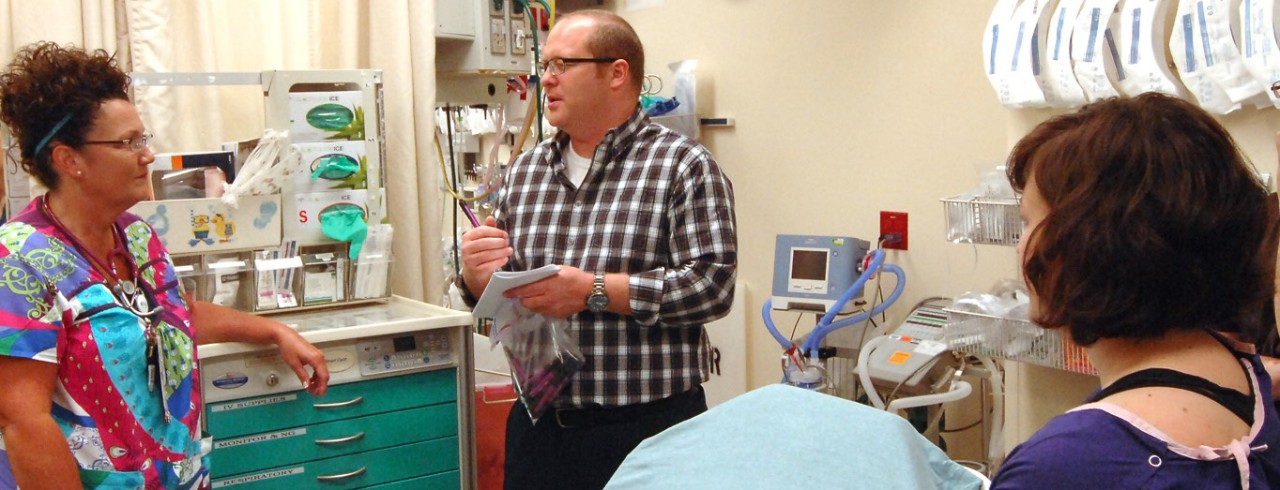
UC researcher helps create and publish international guidelines on violence against health care workers
Guidelines could lead to preventive measures to protect workers
According to statistics kept by the U.S. Occupational Safety and Health Administration (OSHA), serious workplace violence is more common in health care than in any other private sector industry. In an effort to stop what has been described as an epidemic, the Registered Nurses’ Association of Ontario (RNAO) has published best practice guidelines (BPG) through a committee co-chaired by Gordon Gillespie, PhD, DNP, professor and associate dean of research at the UC College of Nursing.
“Workplace violence is four times more prevalent in the health care industry in the United States than it is in private industry,” says Gillespie, who became involved with this project when RNAO members read about his previous research in workplace violence. The organization contacted him in 2017 about co-chairing the panel creating the BPG “Preventing Violence, Harassment and Bullying Against Health Workers,” published in July 2019.
As co-chair with Henrietta Van hulle, vice president for client outreach for the Public Services Health and Safety Association in Toronto, Gillespie helped guide the 15-member RNAO BPG expert panel. They worked in conjunction with the 10-member RNAO BPG development and research team and a team of 44 stakeholders. Gillespie was one of only two people from outside of Ontario to be part of the project.
Gillespie says one key thing he and Van hulle did was give the panel insight into bullying and informed them of the best ways to find the most relevant literature on the topic.
“Even the words they would look up, we would say you can’t limit it to ‘violence,’ you’ve got to have ‘aggression,’” Gillespie says. “For instance, in some countries bullying is called mobbing, so that has to be included in the search. When looking at literature, you have to think what are the alternative words that we need to use to find it?”
With a panel made up of almost all Ontarians, Gillespie says one of his roles was to look at the project as if it was not just for Canada, but for the world, in part because it was going to be translated into Spanish and Chinese, among other languages.
The panel reviewed a wealth of literature on the subject and came up with three recommendation questions:
1. Should health workers be recommended to use risk assessment tools to detect behaviors indicative of workplace violence, harassment and/or bullying?
2. Should organizational policies and procedures to prevent and manage workplace violence, harassment and or/bullying among health workers be recommended to improve organizational and health worker outcomes?
3. Should education and training programs on preventing and managing workplace violence, harassment and/or bullying be recommended for health workers to improve outcomes for persons and health workers?
Those questions had corresponding outcomes and several recommendations from the panel for addressing each one of them, along with how strongly the panel felt about each recommendation.
“One of the biggest issues is doing monitoring surveillance about the problems,” Gillespie says. “If we look at what’s happened in the past, we can do a better job of preventing it in the future. It’s about understanding what the risk factors are and trying to get good instruments to identify and predict who’s going to become violent.”
The guidelines also include structure, process and outcome measures for overall BPG success to track the effectiveness of the recommendations.
Gillespie is hopeful that these recommendations can transform research on workplace violence on health workers from being just descriptive to more preventive.
“A lot of research is being done in the area, but it keeps saying that it’s a problem and nobody is doing anything to change it, so I hope this can help,” Gillespie says. “It will probably be five to 10 years to start to see those type of studies, in part because those require money and workplace violence tends not to be a funded topic.”
Featured photo of Gordon Gillespie at a training session in a hospital emergency department courtesy of the College of Nursing.
Additional Contacts
Related Stories
Pediatrician celebrates 30th UC College of Medicine reunion with...
April 3, 2025
There’s a vital thread woven into the fabric of Chris Peltier’s life. It’s black and red, and it knits all things Bearcat together into a life that was transformed by the University of Cincinnati and the UC College of Medicine.
Hands-on experiences, real-world impact
April 3, 2025
University of Cincinnati second-year medical sciences student Jay Patel is pursuing his passions as founder of the Dahyabhai Foundation, a cancer researcher and a Portman Fellow.
UC Honors students gain hands-on research experience
April 1, 2025
The Biomedical Research and Mentoring Program is open to any University Honors Program students. The faculty mentors are typically from UC’s College of Medicine or Cincinnati Children's Hospital.
